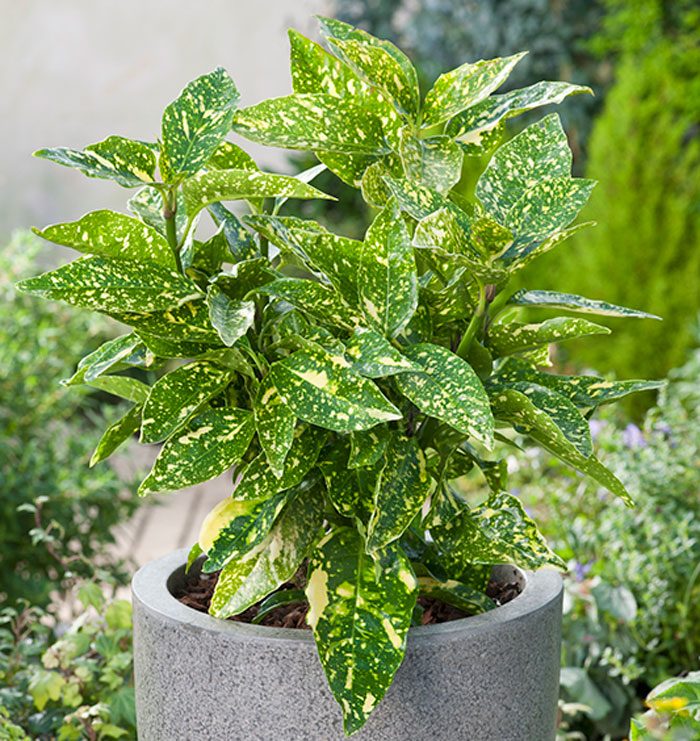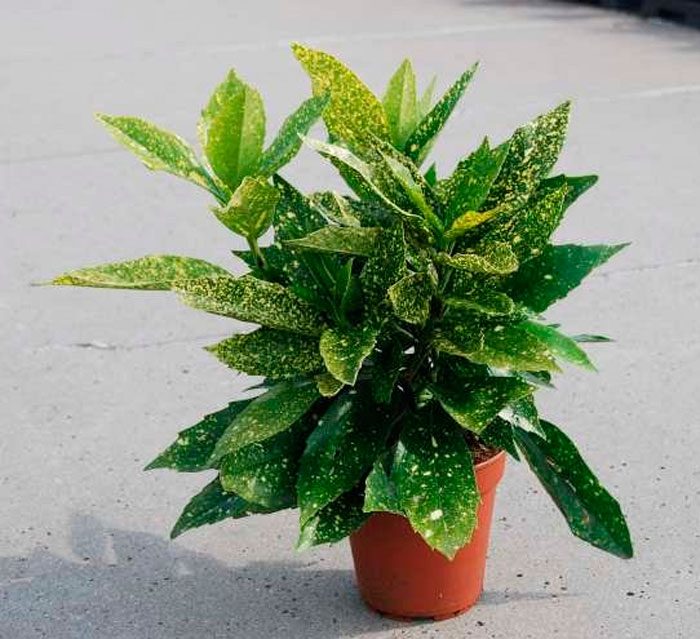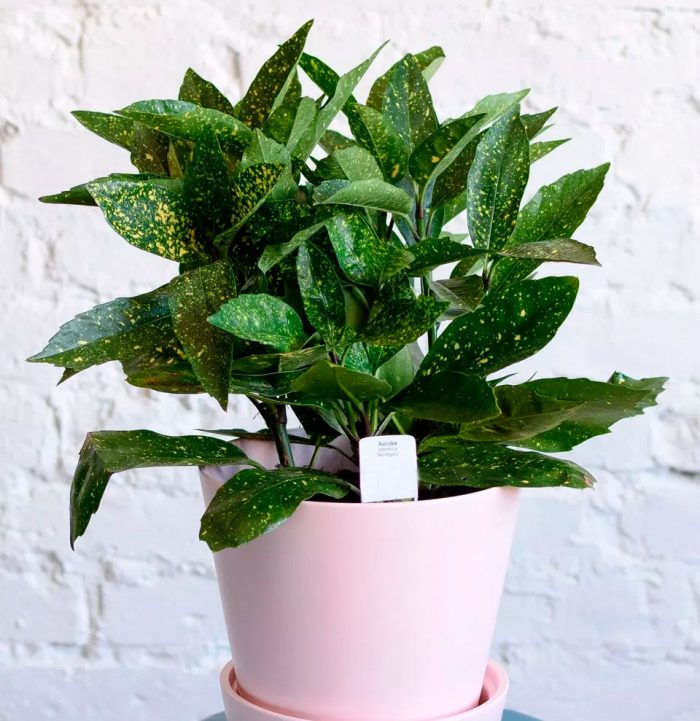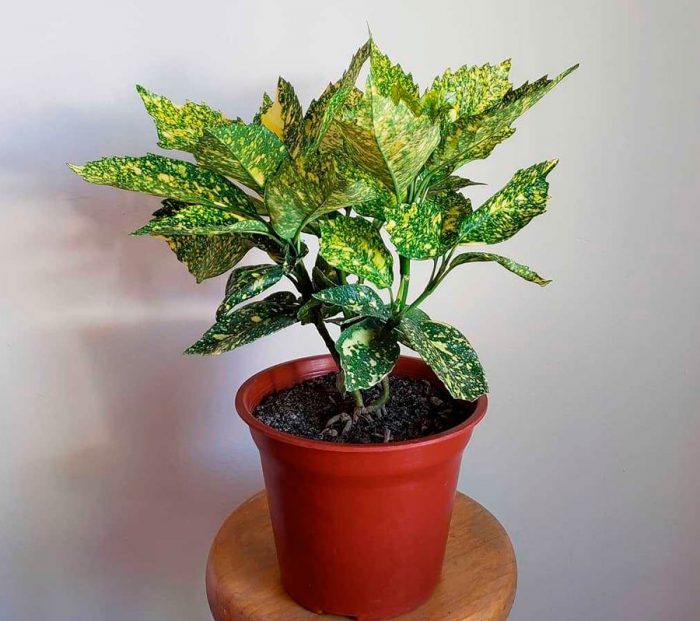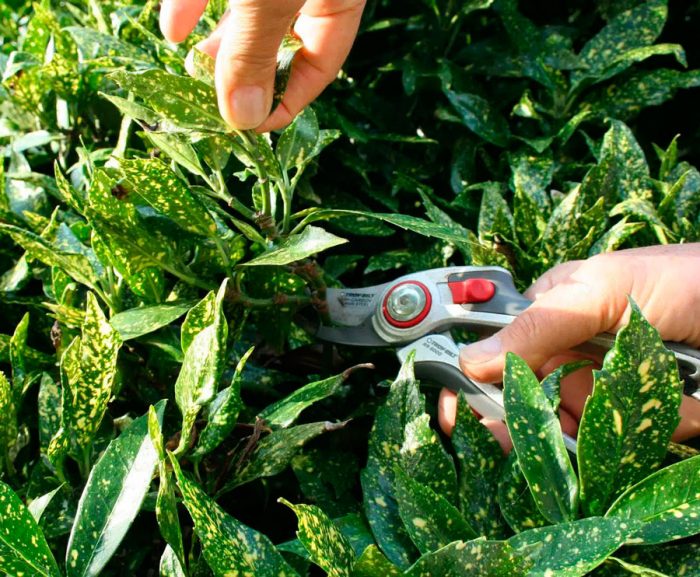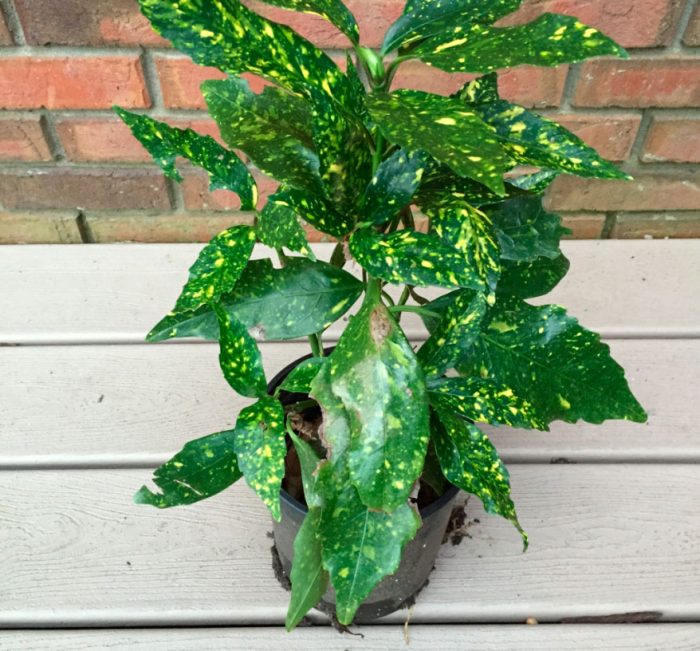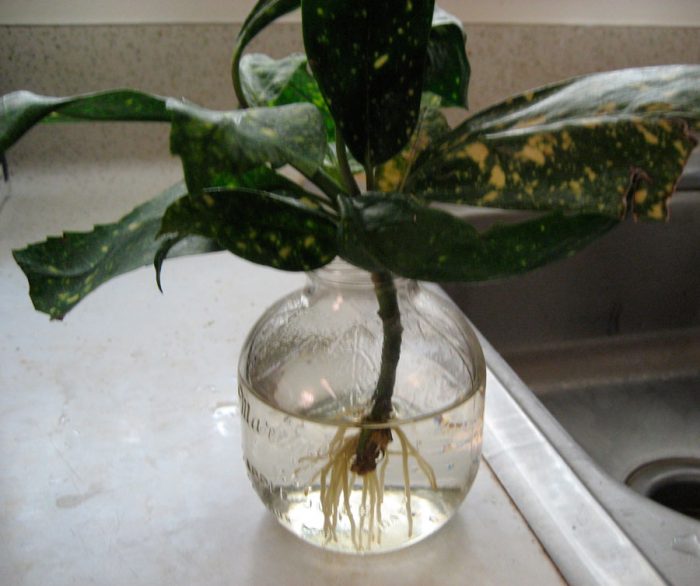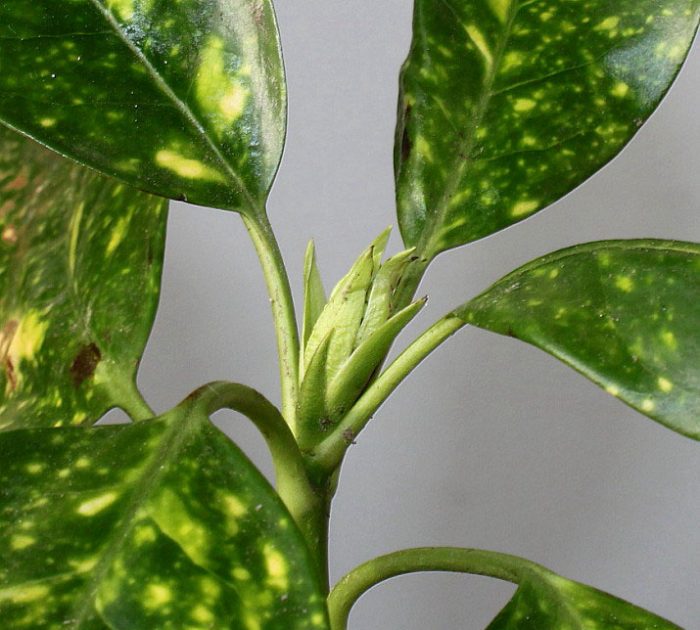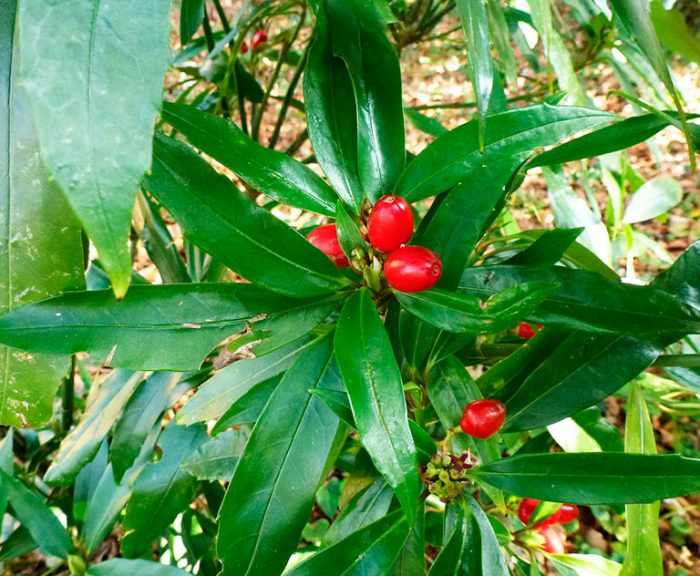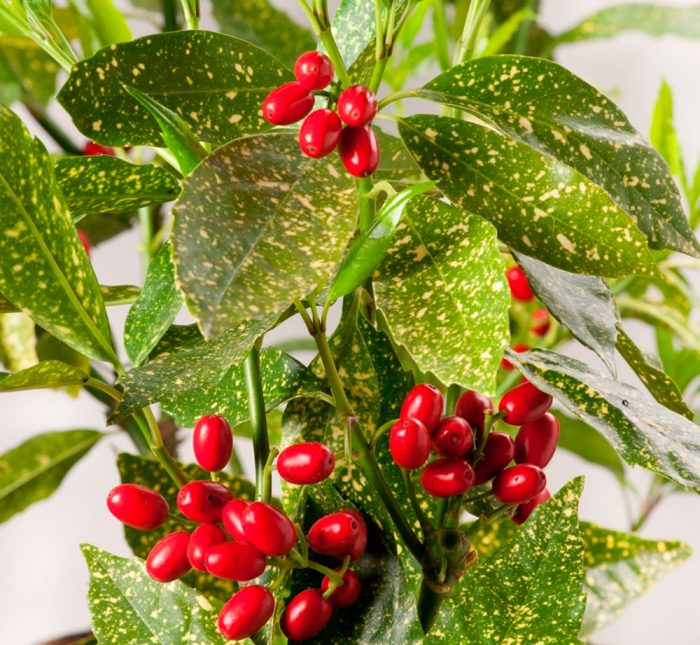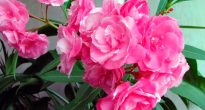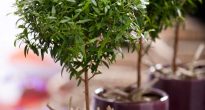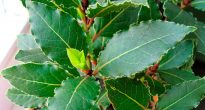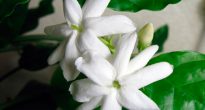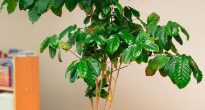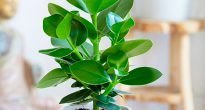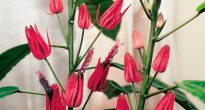The plant Aucuba (Aucuba) is a representative of the Garriev family, and is also sometimes referred to as Akkubov or Kizilov. The genus unites three species, and only 2 of them are cultivated at home, namely: the Himalayan and Japanese aucuba. This plant is distinguished by its shade-loving nature, even in deep shade it grows and develops well, but this does not apply to variegated varieties.
This genus is represented by evergreen shrubs, which are perennials. It is decorated with leathery leaf plates, as well as brownish-red flowers, collected in bunches of inflorescences. In nature, aukuba can be found in China, Korea and Japan. The people also call this shrub "sausage tree" or "golden tree". Thanks to breeders, a large number of various forms of such a plant were born, the foliage surface of which is decorated with small or large yellow spots. There are also such species in which green foliage is located along the edge, and in the middle it is yellow with a ragged outline. After the dying off of the leaf plate, it turns black. In such a plant, foliage is used in alternative medicine.
Content
Brief description of cultivation
- Bloom... Aucuba, cultivated at home, does not bloom often. However, sometimes, under the most favorable conditions, inflorescences are formed on the bush in February-April, which are not of particular decorative value.
- Illumination... Grows normally in both deep shadow and diffused bright light. But forms with variegated foliage cannot be grown in the shade, since because of this, the pattern on their plates becomes faded.
- Temperature regime... In the spring-summer period - from 18 to 20 degrees, and in winter - from 10 to 14 degrees.
- Watering... In the period May-August, the bush is watered abundantly, and this procedure is carried out immediately after the top layer of the substrate in the pot dries. In other months, the amount of watering can vary from scanty to moderate.
- Air humidity... It grows normally at the air humidity level, which is typical for living rooms. In winter, the bush must be moistened with a sprayer.
- Fertilizer... The plant is fed from the first days of March to the last - August 1 time in 7 days, for this, complex mineral fertilizers and organic matter are alternately used. In the autumn-winter period, feeding is not carried out.
- Pruning... Formative pruning is carried out in March, and the young that appear shoots pinch.
- Transfer... This procedure is carried out in March. Until the bush is 5 years old, it is transplanted annually. And starting from the age of five, the transplant is carried out only after the root system becomes very cramped in the pot.
- Soil mixture... Leafy, clayey-soddy and peaty soil, as well as sand (2: 6: 2: 1).
- Reproduction... By cuttings and seed method.
- Pests... Cochineal and mealybugs, thrips, spider mites, whiteflies and scale insects.
- Diseases... Black spots on foliage and rot.
- Properties. All parts of the plant contain poison!
Aucuba care at home
Illumination
The aucuba shrub is a shade-tolerant, or rather, shade-loving plant. It develops well and grows in the shade. However, in a place with bright lighting, it can be grown, but only if it is diffused. When growing variegated forms, pay attention to the fact that poor lighting can cause the pattern to disappear from the leaf plates; therefore, they cannot be grown on north-facing windowsills.
Temperature regime
During the spring-summer period in the room where the plant is located, the air temperature should be in the range from 18 to 20 degrees. If the room is warmer, this will lead to the fact that the bush will age faster, and sometimes it will throw off all the foliage. In winter, the aucuba should be kept cool (10 to 14 degrees). If the bush is warm in winter, it will often need to be moistened from a sprayer, and it will also need additional lighting, otherwise the foliage is likely to fly around. In the warm season, the shrub can be transferred to fresh air, and a place is chosen for it that will be protected from direct sunlight, drafts and precipitation.
Watering
Home-grown aucuba needs abundant watering in May – August. It is necessary to moisten the soil mixture in the pot only after its surface dries out. In other months, watering should be moderate or scanty, in no case should the liquid stagnate in the substrate, as this may cause black specks to form on the surface of the foliage, as a result the bush will lose its decorative effect.
Air humidity
In autumn and winter, it is imperative to moisten the plant, especially if there are working heating devices in the room where it stands. But if the bush hibernates in a cool place, then it must be moistened with care, otherwise mold may form on it. During the spring and summer months, you don't need to moisturize the aucuba.
Fertilizer
Top dressing of this shrub is carried out from March to August 1 time in 7 days. For this, organic matter and complex mineral fertilizer are alternately introduced into the substrate. During the autumn and winter time, this plant has a dormant period, so it cannot be fed.
Pruning
Formative pruning of aucuba is carried out in March, at the same time, young shoots are pinched, due to which the crown will be more lush and effective. The cut tops of the stems can be used as cuttings.
Aucuba transplant
For growing aucuba, wide pots are used, at the bottom of which a good drainage layer is necessarily made. In this case, excess liquid will not stagnate in the substrate, as this can lead to the formation of black specks on the foliage. For transplanting, a soil mixture is used, consisting of peat, leaf and clay-sod soil, and also sand (2: 2: 6: 1). You can also use a soil mixture of the following composition: sand, peat, humus, sod and leafy soil (1: 1: 1: 2: 1).
Until the bush reaches five years of age, it is transplanted regularly once a year.Transplanting an adult aucuba is carried out only if necessary, after the root system becomes cramped in the pot. Experts advise replanting such a shrub using the transshipment method so as not to injure the root system.
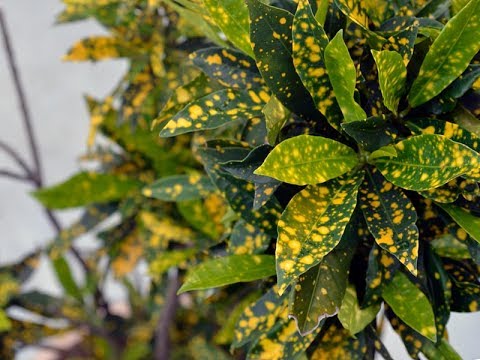

Watch this video on YouTube
Properties
When growing such a plant, it must be borne in mind that each part contains poison... You need to be especially careful with him if there are pets or small children in the house. When you're done with the aucuba, be sure to wash your hands thoroughly with soap.
Reproduction methods
Seed method
Aucuba can be grown from seeds, however, exclusively freshly harvested seed material is used for this, since it loses its germination rather quickly. To obtain seeds at home, you will need 2 adult aucuba shrubs, and they must be heterosexual. Pollination will have to be done manually. Fill a container with wet peat and sow seeds into it, cover it with foil or glass on top. Transfer crops to a place where it is always warm, provide them with systematic ventilation and moistening of the substrate. The first seedlings will have to wait for a relatively long time. After 3 or 4 true leaf plates are formed at the seedlings, they are picked into a soil mixture consisting of humus, sand and sod soil (2: 1: 2). When sowing seeds of aucuba, it should be borne in mind that the seedlings that have appeared may not retain the varietal characteristics of the parent plant.
Cuttings
For harvesting cuttings, use the tops of last year's stems. In order for the cutting to quickly root, it must have at least 3 leaf plates. For rooting, cuttings are planted in sand or in peat mixed with sand. From above, the cuttings are covered with a transparent bag or a glass jar and transferred to a warm place. The cuttings should be systematically watered and ventilated, while the optimum air temperature for rooting is about 22 degrees. Rooted cuttings are transplanted into separate pots filled with a substrate composed of sod and humus soil, as well as sand (2: 2: 1).


Watch this video on YouTube
Possible problems
With improper care or inappropriate growing conditions with room aucuba, the following problems can begin:
- Aucuba leaves turn pale... This occurs when the lighting is overly intense.
- Foliage loses its pattern... The plant lacks light.
- Fading foliage... The bush feels a lack of nutrients, in order to correct this, apply fertilizer to the substrate systematically.
- Flying around foliage... This can be caused by too dry air or excessively high air temperature.
- Yellowing and flying around the lower leaf plates... This may be due to improper watering or a sharp change in temperature.
- The edges and tops of the leaf plates dry out... This can happen due to excessively low air humidity (in winter), due to too bright lighting, or due to the fact that the bush feels an acute lack of moisture.
- Black specks on foliage... This problem appears when the plant overwinters in a warm room, where the air is very dry.
- Pests... Mealybugs, scale insects, spider mites and whiteflies can settle on the bush.
Types of aucuba
Aucuba himalaica (Aucuba himalaica)
In nature, such a shrub reaches a height of about four meters. The shape of the dark green foliage is elongated-lanceolate or lanceolate, and the edge can be solid or serrated. The upper part of the leaf can be sharply pointed to a greater or lesser extent. During flowering, unisexual (female or male) flowers are formed, they are small and do not represent any decorative value.
Japanese Aucuba (Aucuba japonica)
In such an evergreen shrub, woody stems are colored green.Leathery to the touch, opposite shiny leaf plates do not have stipules, they have a serrated edge, they reach about 6 centimeters in width and up to 20 centimeters in length. The shape of the foliage is elongated-oval, and it is painted green, and sometimes there is a pattern on it. The flowers are unisexual and small, they are colored in different shades of red. They are part of the panicle inflorescence. The fruit is a red or orange berry.


Watch this video on YouTube

